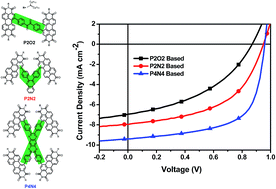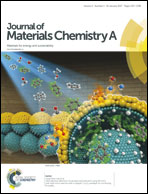Non-planar perylenediimide acceptors with different geometrical linker units for efficient non-fullerene organic solar cells†
Abstract
Three perylenediimide (PDI) acceptors (P2O2, P2N2 and P4N4) were synthesized by functionalizing the bay positions of PDI with benzil, 2,3-diphenylquinoxaline and 2,3,7,8-tetraphenylpyrazino[2,3-g]quinoxaline as linkers, respectively. The photovoltaic properties of the three acceptor molecules have been investigated. The different PDI linker units show different physical and chemical properties of the PDIs. The three PDIs display different non-planar geometrical structures because of the different linker units, which affect the corresponding morphology of the blend films and also influence the charge mobility and fill factor (FF) of the organic solar cells (OSCs). Furthermore, the gradient energy levels of the three PDIs provide an efficient research model for the relationship of device open-circuit voltage (Voc) and energy levels. As the result, the P4N4 based non-fullerene devices show the best photovoltaic performance with a power conversion efficiency (PCE) of 5.71%, whereas the P2O2 and P2N2 based non-fullerene devices show relatively lower PCEs of 2.53% and 3.86%, respectively.



 Please wait while we load your content...
Please wait while we load your content...